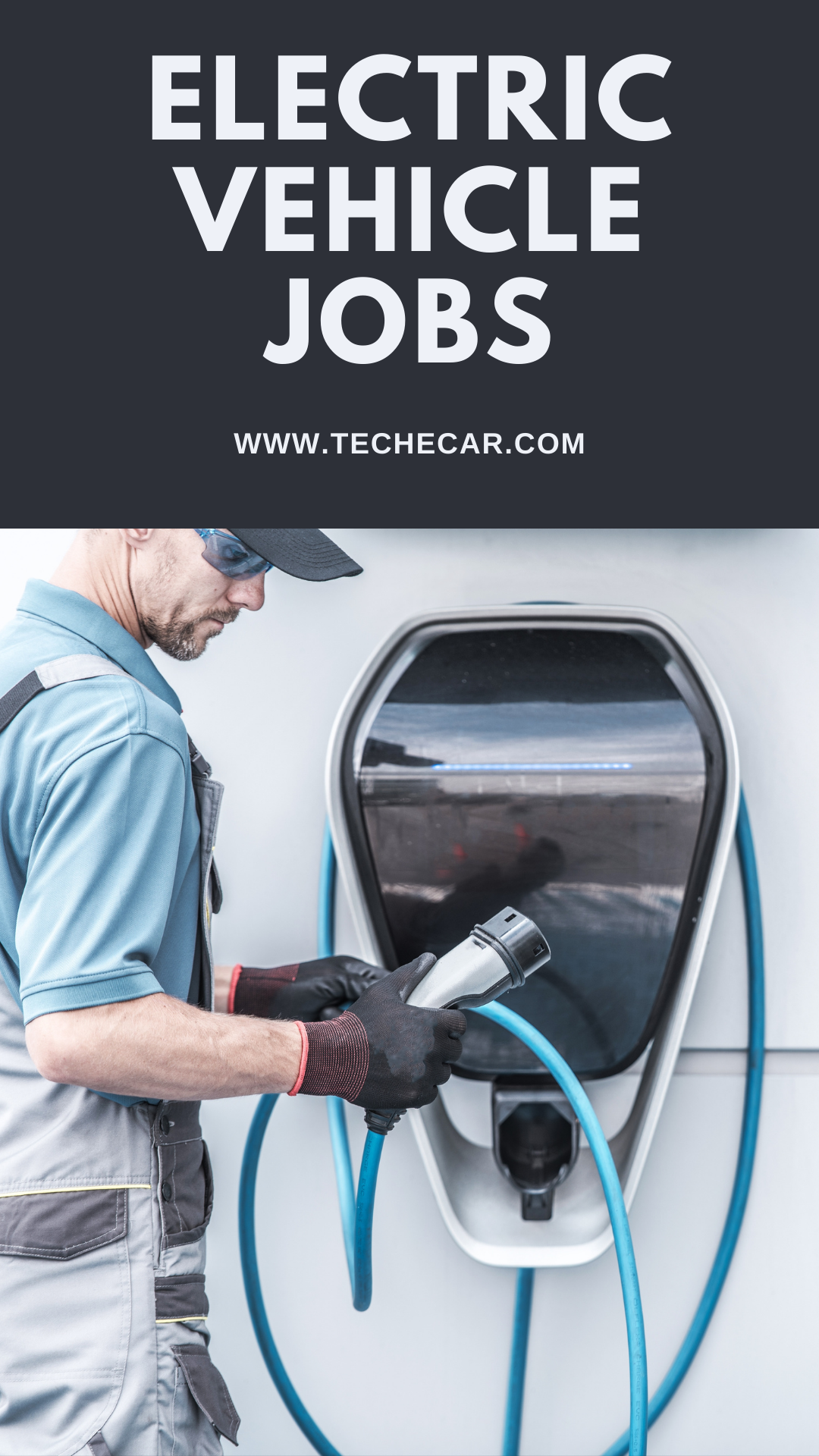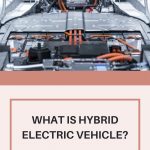Electric Vehicle Jobs
Topic: Electric Vehicle Jobs


Electric Vehicle Jobs
Since the introduction of the first contemporary electric vehicle by General Motors in 1996, electric vehicles have gone a long way. Electric car manufacturers have made significant progress in technology and public acceptance, as evidenced by the recent introductions of the Chevrolet Volt and Nissan Leaf.
Electric automobiles are critical in reducing petroleum dependence, environmental protection, and transportation sustainability. Many automakers have made significant investments in electric vehicle technologies.
Many individuals, particularly those with automotive manufacturing experience, will be employed to produce these vehicles.
This paper details the various job opportunities in producing and maintaining electric vehicles, such as hybrids, plug-in hybrids, and all-electric vehicles. The first section delves into the components and varieties of electric vehicles, followed by a segment that highlights significant roles in the business.
Research and development, manufacturing, maintenance, infrastructure development, and sales are all included in this study. A brief job description; the credentials required to work in these occupations, such as education, training, certification, or licence; and wage data are included in each occupation’s information.
An overview of electric vehicles’ history
Since the invention of the automobile, electric vehicles have existed in some form or another. Many of the original autos were battery-powered rather than gasoline-powered.
In the early twentieth century, electric automobiles even outsold gasoline-powered vehicles. On the other hand, electric vehicles have fallen out of favour as gasoline engines have improved and inexpensive fuel has been available. Several electric vehicle models were built throughout the twentieth century, but consumers generally adopted none.
Nissan Leaf is an all-electric car. Because of growing environmental concerns and rising gasoline costs, electric vehicles regained popularity in the 1990s. In 1996, General Motors released the EV-1 all-electric vehicle and began leasing it. The EV-1, on the other hand, was phased out after a few years.
Honda released the Insight hybrid-electric vehicle in the United States in 2000, while Toyota followed a few months later with the hugely successful Prius. In 2011, GM introduced the Chevrolet Volt, a plug-in hybrid, while Nissan introduced the Leaf, an all-electric vehicle.
Electric vehicles are gaining popularity and sales due to these and other models. Electric car sales in the United States increased from near nil in 1999 to around 350,000 units in 2007. The recession of 2007–2009 impacted all car sales, including electric vehicles. In 2010, electric car sales declined to around 250,000 units.
Many people bought electric automobiles to take advantage of federal and state tax advantages. The federal government devised the tax credits and rebates to minimise reliance on petroleum and strengthen the United States’ position as a leader in electric car technology.
Federal tax credits for hybrid vehicles were available from July 2005 to December 2010; however, they expired and were replaced with equivalent incentives for plug-in hybrid and all-electric vehicles.
Tax credits of up to $7,500 are now available for vehicles, plus an additional $2,000 for charging stations for all-electric and hybrid vehicles. The federal government has also invested in automotive technology to support the electric car industry, such as battery research and development and charging station development.
Some states provide tax benefits to their residents. California, for example, gives tax credits of up to $5,000 on the purchase of an electric vehicle. Furthermore, some states that run HOV or carpool lanes allow electric vehicles to utilise them regardless of the number of passengers.
The growing popularity of electric vehicles can be traced to rising gasoline prices. As the cost of fuel rises, more people are opting for hybrid or electric vehicles to save money.
The BLS does not have data on employment in the electric car industry. However, the Bureau of Labor Statistics is actively collecting statistics to quantify green jobs, particularly those related to the electric car business. In 2012, data should be accessible.
Electric Vehicle Jobs
Electric vehicle classifications
Hybrids, plug-in hybrids, and all-electric vehicles are the three types of electric vehicles. Each type of vehicle functions differently and has its benefits and drawbacks.
Electric hybrid automobiles
Hybrid electric cars, often known as hybrids, use an internal combustion engine and an electric motor to provide power. Hybrid vehicles come in various shapes and sizes, depending on whether the engine or the motor is the predominant source of power.
Some are driven primarily by an internal combustion engine, with an electric motor providing additional power. Others are electric-powered with a gasoline engine as a backup.
A battery and generator power the electric motor. The battery is charged by the generator, which draws power from the internal combustion engine. The battery then drives the electric motor.
In every scenario, having an electric motor allows for a considerably smaller gas engine, saving fuel and reducing emissions from the tailpipe. Regenerative braking, in which energy captured from the brakes is used to recharge the battery, may also be used in these cars.
When travelling in the city and stop-and-go traffic, the vehicle can achieve higher gas mileage. These are the most common types of electric vehicles on the road today. Many automakers offer hybrid models, such as the Toyota Prius, Honda Civic Hybrid, and Ford Escape Hybrid.
Vehicles that are plug-in hybrids
Plug-in hybrids, like other hybrids, include an electric motor and a gasoline engine, but they have a larger battery. They may be charged from a secondary power source while stationary.
Before the battery runs out and the internal combustion engine kicks into power the car, plug-in hybrids can go anywhere from 10 to 40 miles on electricity alone. This type of vehicle includes the Chevrolet Volt.
Vehicles that run entirely on electricity
All-electric vehicles, also known as battery electric vehicles, are powered only by a battery and an electric motor, with no gasoline engine. All-electric vehicles must be hooked into an external source of electricity, such as a charging station, to recharge their batteries when their batteries run low.
All-electric vehicles may travel for up to 100 miles before needing to be recharged since their batteries are more significant than those in conventional electric vehicles.
However, they have a shorter overall range than other electric vehicles because they lack a gasoline engine to take over when the battery runs out. The main advantage of all-electric vehicles is that they do not require gasoline and emit no pollutants. This type of vehicle includes the Nissan Leaf.
Electric automobiles that have been converted
Some gas-powered automobiles with internal combustion engines have been converted to electric vehicles using electric propulsion. Because there are few electric car models on the market, conversion companies frequently do vehicle conversions for customers who want a specific vehicle that isn’t now available with an electric motor.
Vehicle adaptations for specific sorts of vehicles required for business, such as light trucks or passenger vehicles, are also done by businesses.
Jobs in the electric vehicle industry
The electric vehicle business employs workers with a wide range of educational and professional backgrounds, including scientists who perform research in electric drive technology, manufacturing workers who produce the vehicles, and automotive maintenance technicians who fix the vehicles.
The majority of these jobs necessitate specific training or work experience in the manufacturing and maintenance of electric vehicles.
This section describes some of the most frequent positions in the electric car sector; job duties are described for each occupation and the qualifications required for the job, such as education, training, certification, or licence.
Certification verifies a candidate’s proficiency in a skill or set of skills, usually by work experience, training, passing a test, or a combination of the three.
Individual states regulate licencing, which often entails passing an examination and meeting specific qualifying conditions, such as a certain level of education, job experience, training, or completion of an internship, residency, or apprenticeship.
Wage information is also mentioned in the job descriptions. Although the BLS does not currently provide wage statistics for electric vehicle occupations, the earnings listed, when applicable, represent the more significant industry or industry group that would employ electric vehicle workers.
Benefits and other forms of compensation are not included in wage data.
According to a survey conducted by the University of California, Berkeley’s Center for Entrepreneurship and Technology, most employment in the electric car industry are predicted to rise in the following years.
As the need for batteries and charging stations grows, industrial industries and the home energy sector are likely to grow. [number four] New vehicle manufacturing employment will also be created.
Still, many of these positions will be filled by current manufacturing employees or those displaced by the industry’s recent downsizing. During the 2007–2009 crisis, the transportation subsector alone accounted for a large share of the manufacturing sector’s job losses.
Design and development occupations
Engineers, engineering technicians, drafters; software developers; and industrial designers are among those that create and develop electric vehicle technologies. In order to come up with expense solutions to technical problems, engineers apply scientific and mathematical concepts.
Their work connects scientific research with commercial applications. Many engineers create designs for new products by defining requirements, then designing, testing, and integrating components.
Engineers are responsible for analysing a design’s efficacy, affordability, dependability, and safety beyond the design phase. Engineers rely heavily on computers to create and evaluate designs and simulate and test systems. Computers are also required to keep track of quality control procedures.
Engineers work in offices, labs, and industrial plants for the most part. Most companies that produce electric vehicles and their components employ engineers. In the vehicle manufacturing sector, engineering is one of the most sought-after professions.
Engineers collaborate with other engineers, scientists, and industrial production managers to develop new methods or technologies for the production of electric vehicles and improve existing ones.
Several other jobs are vital in the design and development process and engineers. Mechanical drafters and engineering technicians aid engineers with design work and other activities.
Software developers write the code that controls the vehicle’s many systems, such as the engine, battery, generator, and electric motor. Finally, industrial designers are in charge of the vehicle’s general design and major components.
Requirements of the job
Chemical engineers use chemistry principles to develop or improve equipment and devise procedures for the production of chemicals and goods.
Chemical engineers are in charge of developing new battery designs and enhancing present battery technologies since electric vehicle batteries store electricity through chemical processes.
They’re also crucial for creating large-scale manufacturing equipment and procedures and planning and evaluating battery manufacturing methods.
Electrical engineers are responsible for designing, developing, testing, and supervising electrical component manufacturing.
They are in charge of creating the electrical circuitry that allows a gas engine to charge and distribute electricity from the battery to the electric motor. Heating and air-conditioning systems, vehicle lighting, and visual displays are all electrical engineers may operate.
The Chevrolet Volt is a plug-in hybrid vehicle.
Electronic engineers create, develop, and test electronic systems and components for automobiles. These engineers are primarily concerned with the vehicle’s control systems and other electronic components. They vary from electrical engineers in that they are not concerned with power generation and delivery.
Industrial engineers identify the most efficient ways to make automobiles using the primary variables of production—people, equipment, materials, information, and energy.
They are primarily concerned with enhancing productivity through human resource management, technological advancements, and improved production procedures.
Because many electric vehicles have unique production methods, industrial engineers devise new manufacturing procedures and retool plants that produce different car types.
Materials engineers work on creating, processing, and testing electric car materials. Many electric vehicles are constructed of newer, lighter, and more robust materials than traditional automobiles. Environmentally friendly materials created from plant-based resources or recycled materials may also incorporate materials engineers.
Mechanical engineers designed, developed, and tested tools, engines, machinery, and other mechanical components in electric cars. These devices could be electric car components or machines used to produce or repair electric vehicles. Engines, electric motors, and other mechanical devices such as transmissions, drivetrains, and steering systems may focus on these engineers.
Mechanical engineering specialists support engineers in research, development, manufacture, construction, inspection, and maintenance to solve technical challenges.
Compared to engineers and scientists, their work is more tightly focused and application-oriented. Engineers will construct or set up equipment, arrange and conduct experiments, gather data, and compute or record results.
They may also assist engineers or scientists with computer-aided design and drafting (CADD) equipment or prototypes of newly created equipment.
Mechanical drafters create comprehensive drawings that show how machines and mechanical devices are put together. They are in charge of creating visual guidelines that show how mechanical components of cars are constructed. Most drafters utilise computer-aided design (CAD) software to create drawings.
Software developers are responsible for the design and development of software. They build and assess software programmes and systems that make computers run using computer science and mathematical analysis theories.
Modern automobiles are heavily computer-controlled, and software developers create the software that governs them. Furthermore, hybrid and electric vehicles use onboard computers to produce and distribute the appropriate electricity to power the vehicle under specific conditions.
The onboard computer also decides when the gasoline engine should be used to power the car and when it should be used to replenish the battery.
Vehicle aesthetic, function, quality, and safety are the responsibility of commercial and industrial designers. Designers must consider the desires of potential customers and the manufacturing capabilities of manufacturers while creating a vehicle or vehicle component.
To guarantee that the cars meet stated standards, designers must collaborate with engineers and other production team members. They then use computers to create sketches or diagrams and collaborate with engineers and other designers to develop a concept.
Credentials
Engineers with a bachelor’s degree or higher in engineering often work in the electric car business. Some professions, however, necessitate prior experience or a graduate degree.
Entry-level engineers may serve as an assistant to a more senior engineer until they gain the necessary abilities to work on their own. Engineers must also complete continuing education courses to stay current with quickly evolving technologies.
The Department of Energy’s Graduate Automotive Technology Education (GATE) programme offers specialised training for engineering students interested in working on electric or alternative fuel vehicles. The GATE programme has educational programmes at eight universities around the country.
Engineers are typically required to be certified in various systems and technologies, depending on the manufacturer’s systems. Employers prize professional engineer (PE) licences, which are frequently necessary for more than entry-level jobs.
An associate’s degree or certification from a community college or technical school is commonly required of engineering technicians and drafters. On-the-job training is provided to technicians and drafters, who engineers carefully monitor.
A bachelor’s degree in computer science or a similar field and experience in computer programming and software design is often required of software developers. Commercial and industrial designers usually have a bachelor’s degree in engineering or industrial design and some on-the-job training.
Wages
The Bureau of Labor Statistics currently lacks wage statistics related to the electric car industry. In the transportation equipment manufacturing industry group, wages for selected engineers, mechanical engineering technicians, drafters, software developers, and commercial and industrial designers were shown in the table for May 2010. Wages are median yearly wages for the United States; wages vary by company and location.
Manufacturing occupations
Electric vehicle production is a complicated process requiring a large, experienced crew. Because electric car systems are more complicated than standard internal combustion engines, specific manufacturing techniques are required.
Many of the personnel involved in producing electric vehicles have previously worked in the automotive industry. Automotive manufacturing jobs are concentrated in historic industrial cities in the Great Lakes region and the Midwest.
The states with the highest concentrations of these occupations are Michigan and Ohio; however, auto manufacturing factories can also be found in other states. Assemblers, machine tool operators, machinists, and industrial production managers are available in the electric car business.
A few large auto businesses produce finished vehicles, while many of the vehicle’s parts are made by smaller companies that specialise in individual components. The smaller bits are subsequently sold to the more prominent car companies.
Many of the vocations engaged in producing electric vehicles are also involved in the production of vehicle charging stations, which are required for most plug-in hybrid and battery-electric automobiles.
These stations are typically purchased simultaneously as the car and placed at the owner’s residence or workplace. Commercial charging stations have also been constructed across the country.
Electric vehicle owners can use these stations, owned by private companies or government agencies, to recharge their vehicles when they are away from home or work.
Extensive vehicle assembly facilities employ the majority of manufacturing workers. These plants are frequently highly noisy because they are filled with robotic devices, vital equipment, and hydraulic lifts.
Over the last few decades, the safety conditions in manufacturing factories have vastly improved. On the other hand, manufacturing personnel may operate with machines or substances that require particular care.
Responsibilities of the job
Electronic and electrical devices Electric motors, computers, electronic control devices, and sensing equipment are all made by assemblers. Because some of these components are too small or fragile for the human assembly, automated technologies are used to put them together. Electrical and electronic equipment assemblers put together parts of more significant components or operate automated devices that handle smaller parts.
Electromechanical equipment assemblers build and assemble electromechanical components used in electric vehicles, such as gasoline engines, electric motors, and generators, using various tools. Assemblers of electrical and electronic equipment are related to this profession. On the other hand, these workers are more concerned with mechanical components than with electronics.
Other machines and engines Assemblers work on automotive engines, constructing and assembling them. They assemble the gasoline-powered engines found in hybrid vehicles and may also be responsible for other components.
Assemblers work on several manufacturing jobs as part of a team. They can work on a typical assembly line or in a so-called “lean” manufacturing system, which allows them to switch between different types of assembly work. These personnel usually are part of a team that completes a vehicle’s final assembly. They may also put together non-electrical or mechanical car components, such as interiors or the vehicle’s body and frame.
Assembly of automobiles
Operators of computer-controlled machine tools create metal and plastic components for cars. They download a programme and install the relevant tools to set up the equipment for specific operations. Operators of computer-controlled machine tools start after situating the object to be worked on. They may also be in charge of performing routine machine maintenance or troubleshooting if a problem arises.
Machinists use machines such as lathes, milling machines, and grinders to create precision metal parts. Large-scale production of a single part can be partially or automated, with machinists in charge of monitoring the machines and the output quality.
Machinists are also producing small quantities or one-of-a-kind prototypes or test items. If many additional pieces are required, they are frequently mass-produced utilising computer-controlled equipment.
Industrial production managers are in charge of planning, directing, and coordinating cars and vehicle components. They ensure that output and quality targets are fulfilled while staying under budget.
They’re in charge of keeping an eye on the production line to ensure it continues on track and resolving any issues that develop. Industrial production managers may be in charge of the entire plant or just one department, depending on the facility’s scale.
Credentials
Workers in the manufacturing industry have a wide range of abilities. Most assembly jobs involve on-the-job training to familiarise employees with production procedures and any equipment they will be using.
After several years on the assembly line, experienced assemblers may be promoted to supervisory positions. Operators of computer-controlled machine tools are typically taught on the job. Machinists require additional education, and they often learn their trade during a three- to a five-year apprenticeship.
Industrial production managers typically have a bachelor’s degree in engineering, such as mechanical or industrial engineering, and several years of experience working in the automobile manufacturing business.
Wages
The Bureau of Labor Statistics does not presently have wage data for the electric vehicle industry. Wages for selected manufacturing vocations in the transportation equipment manufacturing industry group in May 2010 are shown in the table. Wages are median yearly wages for the United States; wages vary by company and location.
Maintenance jobs for electric vehicles
Electric vehicles, like any other vehicle, require routine maintenance and repair. Average repair professionals can handle much of the ordinary maintenance and repairs, but skilled workers experienced with electric vehicles will be needed for the electrical systems and drivetrain. Workers qualified to work with specific types of batteries are required to repair or install electric vehicle batteries. Batteries must be replaced every few years, depending on usage and battery type.
Responsibilities of the job
Automobile mechanics and service professionals check, maintain, and repair vehicles that run on gasoline, electricity, or a mix of both. They arrange and carry out routine vehicle maintenance and repairs.
Automotive service professionals and mechanics’ jobs have progressed from simple mechanical fixes to high-tech tasks. Sophisticated electrical systems and supercomputers control vehicle performance and safety.
Workers must use computerised shop equipment and work with electronic components and traditional hand tools to fix faults with these systems.
Credentials
Because of the constantly increasing sophistication of automobile technology, automotive service professionals and mechanics are increasingly needed to undergo formal training.
Training usually begins in high school, community college, or post-secondary vocational school. To work at larger repair shops or dealerships, certification from the National Institute for Automotive Service Excellence (ASE) is frequently required.
Formal education might range from a few weeks of on-the-job training to a two-year associate’s degree programme. Before a worker can work independently, they must receive on-the-job training. To become a fully qualified automotive service technician through ASE, you usually need 2 to 5 years of experience.
Automobile repair Working on electric vehicles necessitates specialised skills and expertise from specialists and mechanics. Because electric vehicles employ novel technologies, technicians are typically educated to operate on a specific vehicle and frequently specialise in vehicles produced by a single manufacturer.
Auto manufacturers often provide this specific training to technicians and mechanics. Workers are typically sent to formal training classes by their employers to obtain a specific vehicle type certification.
Workers can learn a wide range of skills needed to work on electric or alternative fuel vehicles through programmes like the National Alternative Fuels Training Consortium (NAFTC). Secondary and post-secondary students studying automotive technology and automotive technicians currently working in the sector can benefit from NAFTC’s curricula and training.
Wages
The Bureau of Labor Statistics does not presently have wage data for the electric vehicle industry. In May 2010, the median yearly wage for automotive service technicians and mechanics working in the automotive repair and maintenance industry was $33,010. The wage is for the entire United States; wages vary depending on the employer and area.
Infrastructure development occupations
There will be an increasing demand for charging stations as the number of plug-in hybrids and battery-electric vehicles on the road grows. Electric vehicles necessitate specialised charging facilities as well as greater electric grid capacity. The majority of these chargers will be in people’s homes or public charging stations. People who cannot refuel their autos at home require public charging stations.
Building charging stations will necessitate infrastructure modifications. Many significant utility companies and certain large towns are already working on measures to deal with the increasing number of electric vehicles. Infrastructure enhancements will be planned by urban and regional planners, with electrical power-line installers and repairers laying the cables that will deliver the extra electricity. Electricians will install the charging stations.
According to research by the University of California, Berkeley’s Center for Entrepreneurship and Technology, installing a statewide charging infrastructure will be the primary source of employment creation related to alternative fuel cars. NAFTC also trains electrical infrastructure engineers and installers.
Responsibilities of the job
Infrastructure modifications to enable electric vehicles are planned and implemented by urban and regional planners. Several towns and local governments are actively supporting and expanding the use of electric vehicles.
To encourage the adoption of these vehicles, city and local government authorities are making changes to municipal electric systems that will allow electric vehicle owners to use public charging stations.
Urban and regional planners figure out how many charging stations are needed to service a particular number of vehicles and where they should be placed to reach the most people.
Installers and repairers of electrical power lines install and maintain the power grid, which is the network of power lines that transport electricity from producing facilities to clients.
Many electric vehicles require specific charging stations to recharge their batteries, and their owners use more electricity than average customers. Installers of electrical power lines install new lines that can handle the additional load.
Furthermore, many municipal governments are constructing public charging stations that will require the installation of new power lines. The new lines are installed and connected to the grid by these installers.
Charging station for electric vehicles
Electricians set up charging stations and any other necessary equipment for electric automobiles. They connect the charging stations to lines installed by electrical power-line installers and ensure the chargers are operational. When a charger malfunctions, electricians are dispatched to make the necessary repairs.
Credentials
Urban and regional planners work for municipal or state governments and need a master’s degree in urban or regional planning or a similar discipline to get started. If they have the required combination of education and professional experience and pass an examination, some urban and regional planners may be certified by the American Institute of Certified Planners.
Installers and repairers of electrical power lines must have a high school diploma or equivalent and basic math and reading skills. Electricity knowledge is beneficial but not necessary for admittance into this career. Employers provide 1 to 5 years of on-the-job training to installers and repairers. Working with high voltage electricity can be risky; hence safety is always emphasised during training.
Electricians should have a high school diploma or equivalent and complete a three-year apprenticeship programme. An electrician receives formal classroom training and on-the-job training from an experienced electrician during an apprenticeship to obtain the skills required to work independently.
Furthermore, most states and municipalities require an electrician to be licenced, which often entails passing an exam covering construction codes, the National Electric Code, and electrical theory. The manufacturer requires electricians to complete specialised training before they are certified to install a specific type of charging station.
Wages
The Bureau of Labor Statistics does not presently have wage data for the electric vehicle industry. Wages for selected infrastructure vocations in May 2010 are shown in the table. Wages are median yearly wages for the United States; wages vary by company and location.
Conclusion
Because they help minimise pollution and reliance on fossil fuels, an essential part of the emerging green economy. Jobs in the electric vehicle business have a lot of room for growth, and employment in all of the major sectors of the industry is likely to increase. Additionally, jobs will be created when the electric infrastructure is expanded to accommodate these vehicles. These new positions will be available in a wide range of fields.
The increasing number of electric vehicles acquired over the last decade and new models announced by numerous manufacturers this year in the United States demonstrate the industry’s progress. As more electric vehicles are purchased, the industry’s employment prospects are likely to expand.





